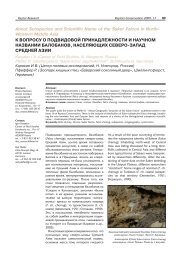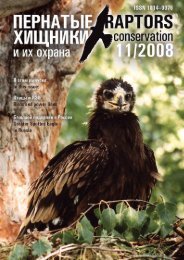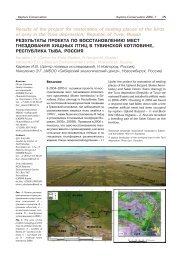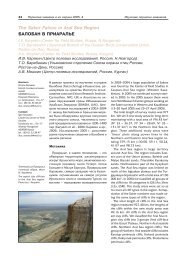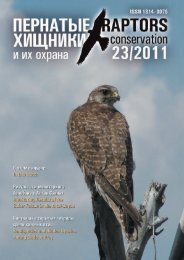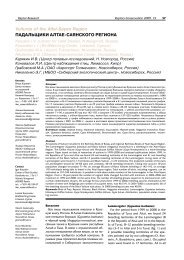Create successful ePaper yourself
Turn your PDF publications into a flip-book with our unique Google optimized e-Paper software.
Raptor Research Raptors Conservation 2010, 20 85<br />
Ðèñ. 1. Òåððèòîðèÿ, îáñëåäîâàííàÿ â 2006 ã.<br />
Fig. 1. The territory surveyed in 2006.<br />
Ïðèãîäíûé äëÿ<br />
ãíåçäîâàíèÿ<br />
ìîãèëüíèêà ó÷àñòîê<br />
ëåñà íà ð. Ò¸øà.<br />
Ôîòî È. Êàðÿêèíà.<br />
Imperial Eagle’s nesting<br />
habitats in the Tesha<br />
river valley.<br />
Photo by I. Karyakin.<br />
çàêàçíèêà, â 2001 ã. íà âåñåííåì ïðîë¸òå<br />
ìîãèëüíèê íàáëþäàëñÿ íà þãî-âîñòîêå<br />
Ïèëüíèíñêîãî ðàéîíà (Êèñåë¸âà, 2003).<br />
×èñëåííîñòü ìîãèëüíèêà íà ãíåçäîâàíèè<br />
â Íèæåãîðîäñêîé îáëàñòè â Êðàñíîé<br />
êíèãå îöåíåíà â 1–3 ïàðû (Êèñåë¸âà,<br />
2003), ïðè ýòîì íàäåæäû íà îïðåäåë¸ííûé<br />
íåäîó÷¸ò âñ¸ æå îñòàâàëèñü âïëîòü<br />
äî 2006 ã.<br />
Îð¸ë-ìîãèëüíèê íàñåëÿåò ëåñîñòåïíîé<br />
ëàíäøàôò, ãäå ó÷àñòêè ëåñà ïåðåìåæàþòñÿ<br />
ñ îáøèðíûìè îòêðûòûìè ïðîñòðàíñòâàìè.<br />
 ëåñó, íåäàëåêî îò îïóøêè,<br />
äîëæíû ðàñïîëàãàòüñÿ âûñîêèå ñòàðûå<br />
(ìàÿ÷íûå) ñîñíû, ñ âåðøèí êîòîðûõ ïòèöà<br />
ìîæåò îñìàòðèâàòü ñâîè îõîòíè÷üè<br />
óãîäüÿ. Èõ ìîãèëüíèêè èñïîëüçóþò äëÿ<br />
ñòðîèòåëüñòâà ãí¸çä è â êà÷åñòâå ïðèñàäíûõ<br />
äåðåâüåâ. Îõîòÿòñÿ îðëû òîëüêî íà<br />
îòêðûòûõ ïðîñòðàíñòâàõ – ýòî, êàê ïðàâèëî,<br />
ñåëüõîçóãîäüÿ. Äëÿ âûêàðìëèâàíèÿ<br />
ïòåíöîâ íåîáõîäèìû êðóïíûå ãðûçóíû:<br />
ñóñëèê (Spermophilus suslicus), õîìÿê<br />
(Cricetus cricetus), ñóðîê (Marmota<br />
in the south of the Sergach region (Zimin,<br />
1974). Starting with 1988, breeding the<br />
Imperial Eagle began to be recorded in the<br />
Ichalki pine forest (Perevoz region, Pyana<br />
River) (Kiseleva, 2003). The number of Imperial<br />
Eagles in the Nizhniy Novgorod district<br />
was estimated in the Red Data Book to<br />
be 1–3 breeding pairs (Kiseleva, 2003); the<br />
hopes for some underestimations still had<br />
been remaining until 2006.<br />
Successful breeding of the Imperial Eagle<br />
in the Ichalki pine forest in the same nest was<br />
recorded in 1988–1991. During that period,<br />
the eagles nested on a dominant pine tree<br />
in the northwestern part of the pine forest<br />
one kilometer away from the forest margin.<br />
In 1988 and 1991, 2 fledglings were recorded<br />
in the nest. Starting with 1993, the<br />
birds began carrying the nest from tree to<br />
tree; it seems that breeding was successful<br />
only several times; and starting with 1995,<br />
no successful breeding was observed at<br />
all. In 1993, the Imperial Eagles relocated<br />
the nest to the site 1.96 km away from the<br />
former one. Then, the nest was disassembled<br />
and in 1995 relocated to the dominant<br />
pine tree growing above the section of the<br />
Pyana river floodplain 50 m away from the<br />
margin. That year, one chick was observed<br />
in the nest; it was the last documentary confirmed<br />
case of successful breeding. In 1998,<br />
this nest was partially disassembled by the<br />
birds and relocated to another site that has<br />
been unknown. In 2000, the Imperial Eagles<br />
moved to the southwestern margin, having<br />
traveled 300 m from the nest being occupied<br />
by them in 1995. In 2004, we found<br />
as many as 2 nests; an old one built on a<br />
not tall pine tree right at the pine forest<br />
margin, and the other, being occupied by<br />
the birds, was built on a dominant pine tree<br />
60 m away from the margin. It was the latter<br />
nest that had been disassembled by the<br />
birds and relocated to the platform that was<br />
built 460 m away from the nest. It is notable<br />
that neither in 2004 nor in 2006, no successful<br />
breeding was reliably observed for<br />
the Imperial Eagles. It should be mentioned<br />
that all the nests, with an exception of one<br />
that was built at the margin, were disassembled<br />
and relocated by the eagles, but not<br />
abandoned and deteriorating. Only several<br />
branches were likely to remain on and under<br />
the nesting tree after the nest was relocated.<br />
The nest built at the margin, in all likelihood,<br />
was abandoned by the birds because<br />
of human disturbance; since almost under<br />
the nest when the birds were nesting, a brick<br />
house was started to build, which was dis-




